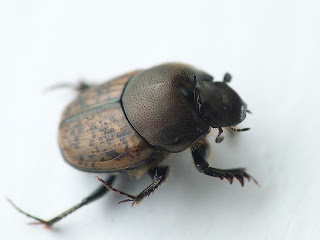I was recently chatting to a fellow beetler who reminded me of a section in the
Coleopterists handbook about how to attract species of beetles that utilise the various stages of decaying carcasses. The idea implanted and I decided to have a go. What's the worse that could happen?
The perfect receptacle seemed to be an old Cambridgeshire Council recycling box filled up with about 4-5 inches of sand (courtesy of B&Q).
All I needed now was a body.....any body.
Over the following few days I came across lots of dead badgers and a couple of muntjac, all of which were just too big for the box. What a I really needed was a rabbit......
But just when I really needed one, rabbits at the perfect point of death were non existent. However fate was at hand as I drove to the tip one Saturday and saw what appeared to be a dead duck by the side of the road.
On the return trip (much to the embarrassment of my son) I stopped and examined the freshly dead female Mallard. The apparent victim of hit and run. In to the car she went and once home, she was lovingly placed on the bed of sand.
I then covered the box with some plastic chicken wire and attached it firmly to the box to prevent any foxes or badgers making off with my hard won quarry!
All that was left to do was wait......
A week went by and the temperatures weren't too high. I went to check the duck which had now been christened 'Donald' despite the obvious sexual misnomer.
A few blowflies were on the carcass but when I turned it a small beetle tried to hide in the sand (what appears to be a histerid(?) but need some further work to ID). This was potted and the duck was returned to its resting state.
A week later (today) and on returning home after 3 rather lovely days on the Gower peninsula in south Wales (more on that later) I decided to check on 'Donald'.........
Wow, almost no flesh left and a writhing mass of thousands of maggots.
A bit of a more thorough investigation revealed 3 (possibly 4) species of staph which have now all been collected to put under the 'scope for IDing. Let's hope that goes better than some of my previous goes at staphs......
Just to give you the full immersive experience. Here's a short video (plus guest appearing staph)!!










